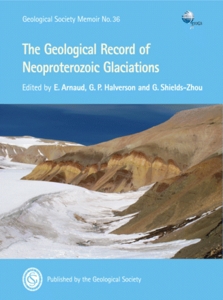Chemostratigraphy and the Neoproterozoic glaciations
Halverson, Galen P., and Shields, Graham (2011) Chemostratigraphy and the Neoproterozoic glaciations. In: Arnaud , Emmanuelle, Halverson, Galen P., and Shields-Zhou, Graham, (eds.) The Geological Record of Neoproterozoic Glaciations. Geological Society, London, Memoirs, 36 . Geological Society of London, Bath, UK, pp. 51-66.
![[img]](https://researchonline.jcu.edu.au/21025/3.hassmallThumbnailVersion/memoirs_cover.gif)
|
Image (GIF) (Book Cover)
- Cover Image
Download (75kB) |
|
|
PDF (Published Version)
- Published Version
Restricted to Repository staff only |
Abstract
Although the pre-glacial Proterozoic isotopic record is poorly constrained, it is apparent that the chemical and isotopic composition of the oceans began to change during the early to mid-Neoproterozoic and experienced considerable fluctuations alongside climatic instability during much of the subsequent Cryogenian and Ediacaran periods. The earliest known large negative δ13C excursion appears to post-date 811 Ma and fluctuations became progressively more extreme, culminating in the late-Ediacaran 'Shuram–Wonoka' anomaly. The negative excursions are commonly associated with pre-glacial and post-glacial times, while extremely high δ13C values are characteristic of strata between glaciations. The precise causal mechanism for these excursions is subject to debate. Seawater 87Sr/86Sr rose during the Neoproterozoic, with abrupt increases following deglaciation consistent with enhanced weathering rates. Reported marine sulphate and pyrite δ34S data exhibit marked variation through this interval, although the changes are not always consistent within or between sedimentary successions of equivalent age. Iron-speciation studies indicate that much of this variation was caused by fluctuating and low sulphate concentrations in seawater, which at times led to the build-up of ferruginous conditions in the ocean. The application of chemostratigraphy to understanding and correlating the Neoproterozoic glaciations evokes considerable controversy, and many questions persist regarding the reliability and calibration of the δ13C, 87Sr/86Sr and δ34S record. Nevertheless, the individual glaciations appear to be characterized by distinct combined chemostratigraphic signatures, in large part due to the generally increasing strontium isotope composition of seawater through the Neoproterozoic Era.
| Item ID: | 21025 |
|---|---|
| Item Type: | Book Chapter (Research - B1) |
| ISBN: | 978-1-86239-334-9 |
| ISSN: | 2041-4722 |
| Date Deposited: | 23 Apr 2012 05:39 |
| FoR Codes: | 04 EARTH SCIENCES > 0403 Geology > 040311 Stratigraphy (incl Biostratigraphy and Sequence Stratigraphy) @ 60% 04 EARTH SCIENCES > 0402 Geochemistry > 040203 Isotope Geochemistry @ 40% |
| SEO Codes: | 97 EXPANDING KNOWLEDGE > 970104 Expanding Knowledge in the Earth Sciences @ 100% |
| Downloads: |
Total: 906 Last 12 Months: 4 |
| More Statistics |




